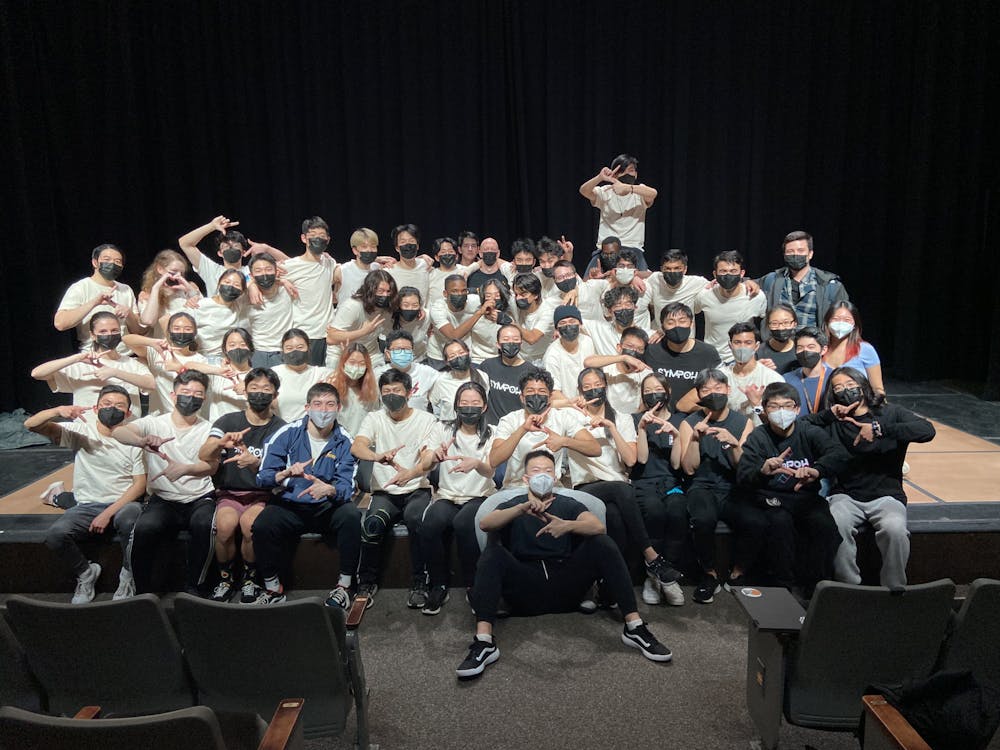Every morning, I clear my inbox of emails with aggressively capitalized, neon-colored fonts, all asking whether I’ve “ever wanted to try” this or am “passionate about” that, touting quick applications and low-stakes auditions. Every evening, I wonder just how much better the food and fellowship are at the eating clubs that hosed my friends. I know the sting of stock rejection letters all too well. On this campus, exclusivity doesn't stop at the admissions process. Princeton’s social scene is cliquish at worst and confusing at best. But sometimes, all it takes to change that is one group taking a different approach.
I was fortunate to find that different approach backstage on “Lucky Break,” Sympoh’s first live show in over two years. What struck me most was the spirit of the company, defined by their no-cut policy: anyone who completes three bootcamps automatically becomes a member.
The choreographers and veteran members cultivated an infectiously positive environment, and the dancers gave luminous performances night after night. The moves were fresh, the pieces were fierce, and the atmosphere was addictively fun. After closing night, I huddled with my crewmates and congratulated all the dancers I had befriended over the past six days. I’m so proud to have been part of such a fantastic production.
One week after the show, Sympoh was planning to host three “bootcamps,” or dance workshops, after which all bootcamp attendees would become official members. My friends in Sympoh made it clear that I would be attending (or else), but they didn’t need to force me. I was eager to join a community for whom “no experience necessary” wasn’t just an advertising point, but a living ethos. I wanted to share in the love they had so generously shared with me — a love for dance and a love for each other.
The choice was Sympoh.
On Feb. 7, 50 future b-boys and b-girls crammed into the lobby of New South for the first bootcamp. Some were friends and roommates of current members; others were enticed specifically by Sympoh’s no-cut promise. When 10:30 p.m. struck, I left my inhibitions at the door and filed into the dance studio. It was reassuring to see many familiar faces, but I had never stepped further outside my comfort zone.
Co-presidents AJ Comsti ’23 and Sabien Taylor ’24 kicked off the night by teaching us to groove. As a musician, I had no trouble feeling the beat, but grooving felt wholly unnatural to me. Grooving gracefully isn’t something you can force, but there is a fine line between looking casual and looking goofy.
Next, AJ walked us through three “toprocks”: the sidestep, kickstep, and the hip-twist (toprock refers to any sequence done from a standing position). Each move involved stepping or hopping out on the even beats and grooving with the upper body. I had a pleasantly awkward time putting all of the moves together.
After drilling toprock for long enough, though, something clicked. Once I committed to embarrassing myself, I began to hit my stride. Putting a bit more energy behind my steps and swings made them sharper, more convincing. I explored sidestep variations and brought my hip-twist up to tempo. Maybe my improvement was all in my oxygen-starved head, but I felt more exhausted and elated than I had in a long time.
At the second workshop, Tuan Dinh ’25, Eric Park ’23, Matthew Sotelo ’25, and my own roommate, Hank Lin ’24, taught footwork, the most iconic aspect of breakdancing. Building upon the basic six-step, I picked up moves like the coffee-grinder, three-step, and kick-outs. At the final workshop, Tuan, Hank, and Matthew taught us three freezes (flashy, acrobatic poses), and Tindar Cyr ’22 demonstrated how to chain toprock, footwork, and freezes together into a coherent set. It was incredibly rewarding to learn and grow alongside my peers, and I was glad to see them all return throughout the week.
Each bootcamp concluded with a “cypher.” Cyphering is the quintessential exhibition of style and skill — everyone forms a circle, and each dancer takes a turn in the middle. The center of the circle is the loneliest, farthest point from the perimeter, but in the moment, everyone feels too close. You can’t hide your errors or insecurities, and there’s no time to think about what to do next. In spite of this, Sympoh made cyphering as comfortable as it could be. It still took all my courage to step out onto the floor, but I felt strong and supported as I hit the hip-twist and spun down into a sorry excuse for six-step. After my set, I cheered on my new friends as they flexed their footwork, attempted the baby freeze, and improvised entirely original moves. Cyphering wasn’t a competition; it was a celebration.
My ankles still haven’t recovered from that week. Neither have my knees, shoulders, or back, but such is the b-boy life. It still feels surreal to say that I’m in a dance group, but bootcamp taught me to embrace the uncomfortable and awakened in me a passion I never knew existed. Sympoh renewed my faith in the fun and friendship to be found at this university. I am eager to explore other no-cut opportunities and reimagine my horizons, but in the meantime, I’ll be on the lookout for my next lucky break.

Sage Kanemaru is a Contributing Writer for the Prospect. He can be reached at kanemaru@princeton.edu or on Instagram at @sagek.ane.








